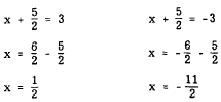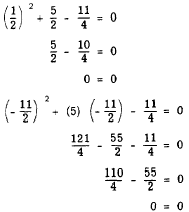|
SOLUTION BY COMPLETING THE SQUARE
When a quadratic cannot be solved by factoring, or the factors are not
readily seen, another method of finding the roots is needed. A
method
that may always be used for quadratics in one
variable involves perfect square trinomials. These, we recall, are trinomials
whose factors are identical. For example,
x2 - 10x + 25 = (x -
5)(x - 5) = (x - 5)2
Recall that in squaring a binomial, the third term
of the resulting perfect square trinomial is
always the square of the second term of the binomial.
The coefficient of the middle term of the
trinomial is always twice the second term of
the binomial. For example, when (x + 4) is squared,
we have

Hence if both the second- and first-degree terms
of a perfect square trinomial are known, the
third may be written by squaring one-half the
coefficient of the first-degree term.
Essentially, in completing the square, certain quantities are added to one
member and subtracted from the other, and the
equation is so arranged that the left member
is a perfect square trinomial. The square
roots of both members may then be taken, and
the subsequent equalities may be solved for
the variable.
For example,

cannot be readily factored. To solve for x by completing
the square, we proceed as follows:
1. Leave only the second- and first-degree terms
in the left member.

(If the coefficient of x2 is not 1, divide through by
the coefficient of x2.)
2. Complete the square by adding to both members
the square of half the coefficient of the x
term. In this example, one-half of the coefficient
of the x term is 5/2, and the square of 5/2
is 25/4. Thus,

3. Factor the left member and simplify the right
member.

4. Take the square root of both members.

Remember that, in taking square roots on both sides
of an equation, we must allow for the fact that
two roots exist in every second-degree equation.
Thus we designate both the plus and the minus
root of 9 in this example.
5. Solve the resulting equations.

6. Check the results.

The process of completing the square may always
be used to solve a quadratic equation. However,
since this process may become complicated in more complex equations, a formula
based on completing the square has been developed in
which known quantities may be substituted in order to derive the roots of the
quadratic equation. This formula is explained in the
following paragraphs.
|
|

